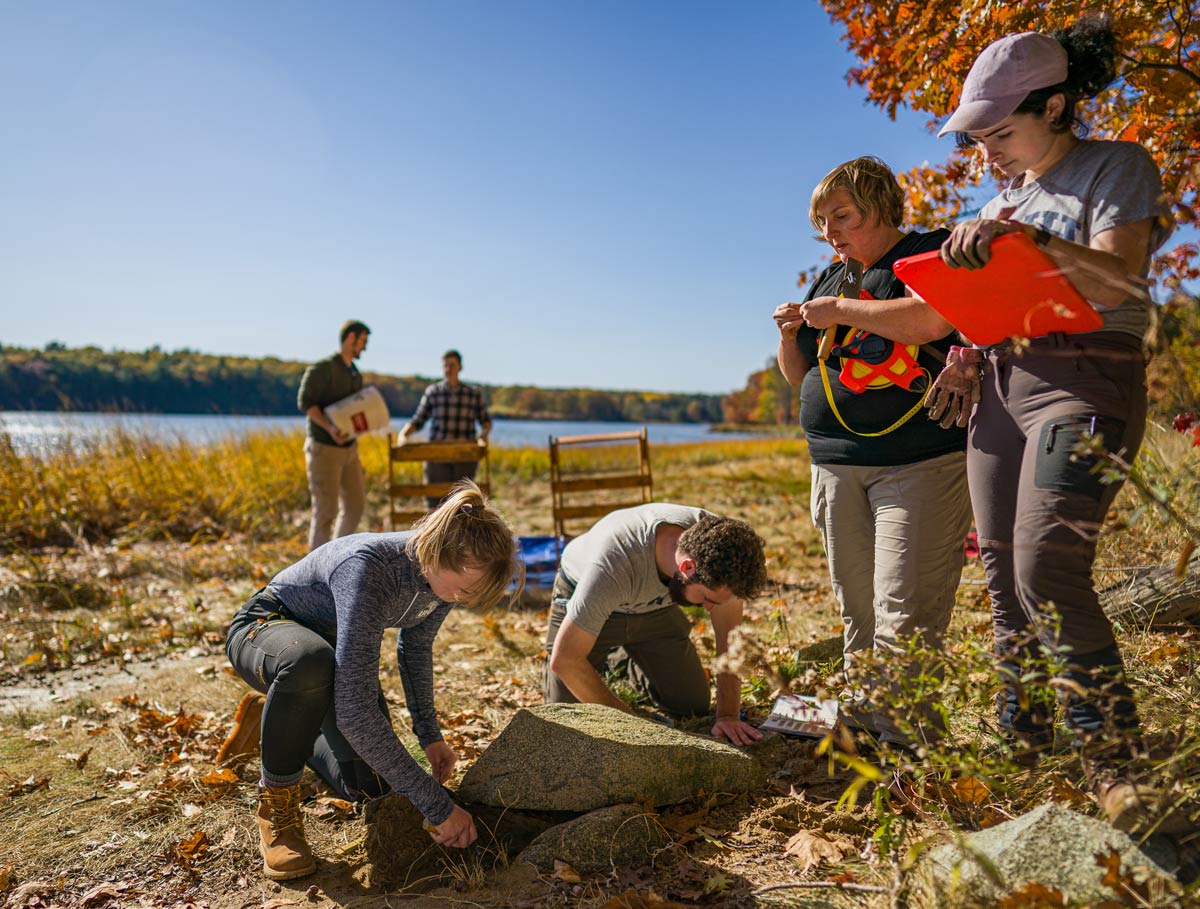
Digging for History
hen Exeter resident Nan Nutt dug up an egg-shaped rock at an archaeological survey in Durham, her first thought was, “It’s just another rock” — the site was full of them. But there was something about its shape and smooth exterior caused her to pause before tossing it aside.
That rock, it turns out, was an Indigenous stone tool found in the hearth of a 17th century British homestead. And finding that tool in that location had great significance: It was key to discrediting the colonial narrative about the savagery and warfare of the Indigenous people living in the region at the time. Coupled with evidence of Indigenous food remains in the hearth, it became clear that there was a peaceful relationship and exchange between the colonials and the Indigenous people, at least for a generation or two.
Nutt, a retired immunologist with a passion for Early American history, is one of the community volunteers working at the field site, which is part of the Great Bay Archaeological Survey (GBAS), a five-year dig on the banks of New Hampshire’s P8bagok Bay — the Indigenous ancestral name for Great Bay. Meghan Howey, a UNH professor of anthropology, leads the GBAS project and has since summarized the findings online — a website called “From the Fragments,” where the public can read more about the project, hear interviews with participants and see photos of the findings. Howey’s excitement over the history revealed from GBAS is equally matched by her enthusiasm for the volunteers and the skills they brought to the project.
“To really understand this region’s history, you need to understand the nitty gritty of ceramics, of who sold what land deed to whom, and I didn’t know that stuff,” Howey says. “I started asking around, looking for local amateur historians, genealogists, people who are already studying these topics to be part of the GBAS team. They’ve taught me everything I know about colonial artifacts. Knowledge doesn’t just come from academia.”
To that end, Nutt’s previous experience in collecting underwater biological samples has translated well to digging in the soil along the Oyster River. “The sampling procedures — things like creating grids, collecting specimens and making sure they are documented properly — are basically the same, regardless of whether it’s underwater or on the land, ” she says.
Nutt was recruited to the GBAS team by Diane Fiske, the historian of First Parish Church in Dover, who served as the research historian for the GBAS Project. During the past five years, Fiske studied historical property deeds, guided the team on excavation locations and conducted genealogical research to better understand the relationships among the families who lived in the region. A fervent fact-finder, Fiske is determined to either verify historical tales or disprove long-held beliefs. “There are so many mistakes in our written history,” she notes. “It’s important for more people to understand the real stories of how we got here and how we happen to now ‘own’ the land.”
Denise and Paul Pouliot, the head female and male speaker, respectively, of the Cowasuck Band of the Penacook Abenaki people, were early collaborators on the GBAS project, having established a working relationship with Howey many years prior. They described the dig in the estuary as ‘surreal.’ “When we go to an archaeological site, we don’t normally get asked at the onset to offer prayers and ceremonies asking for guidance from our ancestors, but we did for this site, and within hours the team began pulling artifacts out of the ground,” Denise Pouliot says. “Normally we dig for days and might only find one little speck.”
UNH anthropology graduates and students take part in the field excavation as well. Every physical artifact they find is washed, catalogued and stored by Emily Mierswa ’18, who has served as the GBAS Archaeology Lab Manager since 2017. In her role, she helps to plan for each archaeology field season and manages the record-keeping. From tiny fragments of porcelain cups to French gunflint, Mierswa has kept tabs of it all.
“A project like this that offers free opportunities to learn archaeological field methods is so rare,” Mierswa says, noting that her work on GBAS helped get her admitted to graduate school at Simon Fraser University, where she is currently pursuing her master’s degree in archaeology.
Denise and Paul Pouliot were able to provide their insights about the artifacts and evidence found and offer their thoughts on how they were used. “We might look at the soil and note that it looked like they were melting fat at the fire, so we would recommend doing a specific type of lipids test to learn more,” Paul Pouliot says. “We bring the cultural perspective that is lacking. No level of academic degree can match that.”
“We need everyone, people with all different skills, to be involved in a project like this,” Denise Pouliot says, noting that this model of a community-engaged project helped to make it a success. “What we’ve found will rewrite the book on our history,” she adds.